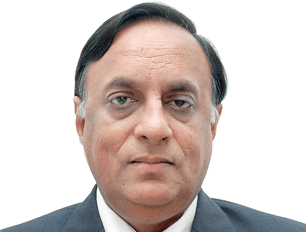
The Goods and Services Tax (GST) Council recently fixed the GST rates for a clutch of items, including textiles and garments, almost completing the exercise of rate fitment. On track to roll out the new indirect tax regime from July 1, the apex body of Central and State Finance Ministers also approved the rules pertaining to transition provisions and filing of returns, in the process addressing some concerns of the industry over the earlier drafts.
There is no rate shock either for the highly labourintensive textiles and garments sector. Although many manufacturers of unprocessed fabrics (Powerlooms) that are currently exempt will now come under the tax net (due to the lowering of the turnover threshold for taxation to Rs. 20 lakh for GST from the present Rs. 1.5 cr for excise duty and the imposition of 5 per cent GST on grey fabrics), the seamless input tax credit (ITC) chain would soften the cumulative tax burden, industry analysts said. In the new system, for the textile value chain, full tax credit would be available but no overflow of credit would be permitted.
This means the ITC will be restricted to 12 per cent even if the total taxes paid on raw materials are above 12 per cent, sources said. However, readymade garments, especially those costing up to Rs. 1,000 per piece, could become cheaper because the 5 per cent GST rate is much lower than the current duty incidence, industry sources said.

J Thulasidharan Chairman, The Confederation of Indian Textile Industry (CITI)
We hail the government’s decision to trim the GST rate for job work in textile yarn and fabric manufacturing activity from the proposed 18 per cent to 5 per cent. But the high rates of 18 per cent announced for MMF, fabric and yarn, dying and printing units and embroidery items can lead to an increase in input costs and can adversely affect the entire textile value chain. This will come as big blow to small fabric manufacturers in powerloom, knit and processing segments and prevent seamless flow of input tax credit and allow breakage of value chain.
The industry has been demanding a reduction in the excise duty on man-made fibres, saying such a disparity is preventing domestic synthetic fibre producers from scaling up operations. The huge duty difference has ensured that India’s textile market remains cottondriven, in a stark contrast with the trend globally, apart from eroding the country’s export competitiveness in the man-made fibre segment. While man-made fibres account for around 60-70 per cent of the world’s total fibre consumption, they make up for just 30-40 per cent of Indian fibre demand (with cotton textiles contributing the rest).

Ujwal Lahoti Chairman, The Cotton Textiles Export Promotion Council (TEXPROCIL)
The rate of 5 per cent for cotton textiles is very progressive and will lead to the growth and development of the entire value chain. TEXPROCIL welcomes the rate of 5 per cent for yarn & fabrics and thanks the Honb’le Minister for Finance for accepting the Council’s suggestion for keeping the rates low in order to ensure compliance & encourage the farmers to grow more cotton. We also thank the honb’le Minister of Textiles for extending her unstinted support to get low rate of 5 per cent for the cotton textiles sector. These low rates will not cast any additional burden on the sector & will ensure that India regains its competitiveness in the textiles sector in world markets.
We request the government to announce draw back rates to take into account the unrebated duties under GST & continue the ROSL Scheme for made ups & also extend it to fabrics & yarn. The GST rate for textiles will eliminate the cascading effect of duty/taxes which will reduce the costs and improve the competitiveness of the textiles exports. We request the Government to ensure speedy refund of Input Tax Credits on exports so that exporter’s fund does not get blocked.

Anil Varma President, Delhi Exporters Association (DEA)
First of all I would like to thank Arun Jaitley, Finance Minister, Govt. of India for this bold decision and supper efforts to reach this stage where all states has agreed to implement this decision, which was lying pending for more than a decade. Still I feel that GST should not be imposed to trade, till all points are cleared and understood by the trade. Even as on date there are many unanswered questions, which we feel will be big confusion for trade. The trades such as exporters are not aware about status of DBK, ROSL & MEIS license.
The GST rates are in 6 slabs percentage wise i.e. 0 per cent, 5 per cent, 12 per cent, 18 per cent, 28 per cent & 40 per cent, which is very difficult for traders to understand and to classify their products in HSN code. We suggest 0 & 12 per cent GST rate classification only. This is the first time in the history of independent India that basic items like textile, education & traders less than 0.20 cr turn over are also going to be in the net of GST.
Apart for this, job work for exporters of textiles, such as fabrication, dyeing, printing, embroidery, sequence work on fabric & garments are some of many points which are not clear to the trade. The open house and discussion meets, organised by trade bodies, are also not aware about clear position on many issues. In fact if an entrepreneur attends some of these lectures then he becomes more confused after the meet.
A delay of two months and sorting out problems/lectures from authorised officers of Govt. of India may be able to bring more and more clarity in the minds of exporters/ traders. I request FM of India to consider our suggestions and hold GST implementation till end Aug. Otherwise we will have the same problems as the trade has faced during demonetization in the month of November 2016 and the Finance Minister will come with new amendment on day to day basis.

Ashok G Ragani Chairman, Apparel Export Promotion Council (AEPC)
GST, which is one of the biggest indirect tax reforms, is overall positive for the apparel and garment sector and its rollout will allow the sector to remain competitive in the long run. The streamlining of indirect taxes will account for ease of doing business and calibration of value added services will only strengthen the formal sector.
To gauge the impact of GST on the cotton garments a calculation based on the pre & post GST rates has been worked-out and it largely suggests that the major items like T-shirt, shirt, pant, dress & blouse would be cheaper post GST rollout in case they are branded and are priced at Rs. 1,000/- and above. In case of unbranded garments, there will not be any change since there was a 5 per cent VAT and the applicable rate of GST would also be 5 per cent.
The raw cotton is expected to be little cheaper, but the cotton yarn which is hitherto expected to attract 5 per cent GST, shall be making it little expensive. Similarly cotton yarn exports will get little expensive, but since the input tax credit would be available, composite mills would be benefitted as individual stage-wise taxation will not be levied.
So overall, the GST rollout will help in improving the cost competitiveness. In the current indirect tax regime, taxes are levied at each stage with excise duty being levied on manufacture. When this is compared with GST, which is levied only at point of sale and not at the point of purchase and manufacturing, the consumer will be bearing only the GST charged by the last dealer in the supply chain, thus simultaneously making it cheaper for the consumer and increasing the profitability of the business. However, SMEs that manufacture consumer goods which are sold directly to end-customers- and were hitherto exempt due to the turnover threshold– will come under the tax net and thus see their customers pay a higher price.
Apparel industry has been registering a double digit growth despite global headwinds vis-à-vis our competitors like Bangladesh, Vietnam, Pakistan and Sri Lanka. In spite of this, industry is deeply concerned on the amount of losses it will have to bear on account of the withdrawal of the schemes like ROSL (rebate on state levies), duty drawback, interest subvention etc. AEPC has written to the Finance Minister to allow States to incentivise on the inputs used under ROSL scheme so that the industry continues to remain competitive.

Rahul Mehta President, The Clothing Manufacturers Association of India (CMAI)
The textile industry has urged the government to apply the lowest GST rate of 5 per cent across all value chains in the textile and apparel sector, to avoid any possibility of tax evasion. While the final decision on the rate is yet to be decided, the draft rules propose four slabs — 5, 8, 12 and 18 per cent of tax under GST. Currently, the applicable rates vary between 5 and 7 per cent, depending upon the use of raw materials and production of finished products.
A low GST rate of 5 per cent applied uniformly across the sector will propel domestic production, besides facilitating and encouraging voluntary compliance. This would help India achieve its target of generating 35 mn jobs and attracting investments worth $200 bn by 2025. The demand assumes significance in the wake of textile sector being the largest employer of skilled and unskilled workforce after farming.
The textile industry provides direct employment to 45 mn individuals and generates 60 mn indirect jobs. The industry also contributes 10 per cent to manufacturing production in the country. With textiles commodities holding a seven per cent weightage in the Consumer Price Index (CPI), it is an essential commodity in the Indian consumption basket. Its functioning, therefore, has a considerable ripple effect not only on the economy, but also on the lifestyle of individuals.
A uniform 5 per cent rate of GST with no exemptions in the sector will remove current blocked input taxes and tax cascading present in the industry, while also providing revenue enhancement for the government. Even with 50 per cent compliance from the industry, the tax revenue across the value chain under a uniform GST rate will see and increment of Rs. 7,000 cr.
A multi-tiered GST rate structure, on the other hand, will lead to distortions in production and consumption. It will also compromise fibre neutrality with producers moving to manufacturing garments made from fabrics that are taxed lower. Such a structure may also lead to disputes in the classification of textile products to different tax categories, experts believe.
GST can transform the textile industry into a single market with a predictable tax system, enabling increased value addition, employment and exports. This scope of GST to carve out a promising future of sustained growth for the textile sector can be achieved only through the application of a uniform low GST rate to the entire sector.
According to trade sources, a comprehensive uniform low GST rate has the potential of not only removing inefficiencies associated with exemptions and cascading in the sector, but also of increasing the government’s revenue three fold. Currently fabrics are exempted from taxes. They account for as much as three– fourth of total consumption spending on textiles, estimated to be around Rs`4.34 lakh cr in 2015-16. Extension of the tax base to fabrics and assuming 50 per cent of compliance, the government would generate Rs. 10,850 cr.

Narain Aggarwal, Chairman The Synthetic & Rayon Textiles Export Promotion Council (SRTEPC)
GST is being discussed by everyone who is involved in any kind of business activities of any scale. I must appreciate the receptiveness of Ministers and officials who are involved in rate and policy formulation of GST, trying to understand the miniscule details and problems of the industry and solve the same to the best possible. Being related to textiles, which is a highly decentralised industry and second largest employer after agriculture, there have been issues which when represented have been resolved in the interest of trade, some still remain which may be addressed in the GST council meeting on 18th June. We have to understand that from 1st July onwards GST shall be a part of our business activities and any individual doing business has to incorporate it in its daily commercial activity, shying away from it shall not help. It’s high time that problems involved in implementation of GST rates, which make a product costly, should be put forward and brought to the notice of concerned officials.
GST is also going to impact imports, which till implementation have been subjected to a different duty structure. Textile industry fears, huge influx of import in the form of fabrics which can hit the domestic industry and derail the entire chain of production of MMF textiles particularly fabrics. Necessary safeguard needs to be in place to check under import of Chinese fabrics, which at present is about $4,000 cr annually. This alone accounts for a production loss of 1.6 lakh tonne of yarn (approx.) and subsequent 240 cr mtr of fabric (approx.). If import prices are undervalued then above mentioned figures could escalate. In the current GST structure all activities of production in MMF and cotton except spinning of MMF which were previously exempted from Central taxes and VAT was levied at yarn and garment stage are to be taxed ranging from 5 per cent to 12 per cent to 18 per cent in MMF sector and 5 per cent to 12 per cent in natural yarns. This is surely going to increase cost of fabric and/or garment in the hands of the customer by few percentages. I will request that government should take corrective steps by imposing import duty in a manner that can safeguard domestic industry. Hoping for positive steps in this direction.

N Vivekanandan, President South India Imported Machine Knitters Association (SIIMKA)
We welcome the GST bill. We also thank the GST Council, Finance Minister and the Textile Minister for favourably considering the appeal made by the Association for reducing the service tax from 18 per cent to 5 per cent.
The 5 per cent GST levy on cotton yarn and fabric would make interstate movement of goods smoother and business would become transparent. A small increase in the product rate would become immaterial once business goes with uniform tax rates across the country. I believe that the reduction of service tax from 18 per cent to 5 per cent would greatly benefit the MSME segment and have a level playing field with the vertically integrated manufacturing units.
The Tirupur textile cluster is currently having around 2,000 apparel manufacturing units and approximately 5,000 garment accessory units involved in knitting, dyeing, compacting, printing, embroidery, etc. So we request the GST council the term fabrics would apply only upto the stage of finished fabric cutting and thereafter they would be termed as garment or made-ups or any other products and therefore, suitable amendment / inclusion is required for the benefit of textile value chain. We also request the GST Council for reducing the GST rate on manmade fibre, filaments and spun yarn from 18 per cent to 5 per cent as the fabric would attract only 5 per cent GST rate. Overall, I am very confident that Tirupur knitwear industry will touch 1 lakh cr 2020 and further dizzy heights as a preferred knitwear hub in the near future.

Ganesh Kumar Gupta President, Federation of Indian Export Organisations (FIEO)
The job work in cotton, blend, MMF, should be included under 5 per cent GST uniformly for yarn, fabric, garments, and made-ups, whether woven or knitted and irrespective of fibre-base. The apparel manufacturing industry heavily depends on job works and they should not be left out from the overall 5 per cent tax treatment for the sector.
Major global trade is happening in high and medium technology sector where India’s share is absolutely low. China has constantly increasing its share in this sector and thereby showing quantum jump in exports. We urge Commerce Secretary to provide fiscal stimulus to high and medium technology sector in the Mid-term review of the Foreign Trade Policy. There is a need to build India’s reputation of being the leader in software to sell our hardware and software embedded hardware.

Raja M Shanmugham President, Tirupur Exporters’ Association (TEA)
We thank GST council for timely intervention for reduction of GST rate for Job work in textiles in the previous Council meeting held on 11th June 2017 and also unfortunately, the GST council not covered the ‘Job work on apparels’ within the ambit of this rate reduction and this negative step would likely to cause huge hardship to several micro industries in textile clusters like Tiruppur. Only the services which can be classified as ‘Job work in relation to Yarn and Fabrics of textiles’ alone is eligible for the reduced rate of 5 per cent.
Some of these processes such as checking, ironing and packing, button fixing, etc., are actually carried out by people ‘who take work to their home for job work’, which was also rightly described by our Hon’ble Finance Minister. As the processes are only of B2B nature and since the final product garments is falling under 5 per cent slab, levying 18 per cent on job work will create an inverted duty scenario disturbing the seamless credit flow thereby defeating the very object behind GST.
The laudable intention of removing the hardship for the MSME industry by reducing the GST Rate on job work will not be fully served if only these tiny and micro industries such as those listed above are excluded from the benefit of rate reduction. As these job workers fall in the middle of the textile manufacturing value chain where the credit is ultimately passed on to the final manufacture, there is absolutely no revenue implication because this change as suggested.
We appeal to the Hon’ble Union Minister of Finance to discuss the concerned issue at the ensuing GST Council meeting and request to make a suitable amendment /clarification so that this unintended hardship faced by micro and small textile units in Tirupur cluster are duly addressed.

AC Eswaran, President, South India Hosiery Manufacturers Association (SIHMA)
The 18 per cent GST rate on ‘services’ would affect the hosiery sector badly since most of the work in the production chain is usually outsourced by the main manufacturing units.
Such work is handled by cottage units, which mostly do not have any exposure to computers or paper works related to tax. They are scared and worried due to GST. Assuming they can handle this, the biggest challenge is working capital that will lead to units closing down.

K Selvaraju, Secretary General, South Indian Mills Association (SIMA)
SIMA welcomes the GST rates for the entire textile industry with open arms. It is as an ‘excellent tax structure. It would definitely strengthen our industry since we are predominantly cotton-based. Sustainability and competitiveness will sustain. In my opinion, for the first time we are having an excellent tax structure. A lot of disparities have been sorted out by the existing government before the big rollout of GST.
The industry hoped that textile job work would be exempted from service tax. This is essential as most of these units are MSMEs and due to the predominantly decentralised nature of the industry, especially the powerloom, knitting, processing, and garmenting sectors. 18 per cent GST rate levied on man-made fibre and synthetic yarn would have inverted duty structure problem as the fabric would attract only five per cent GST rate. The association expects around 30- 40 per cent stoppage of production in powerloom and garment knitting, which will put pressure on the industry.

Ammanabolu Prakash President, Telangana State Federation of Textile Associations (TSFTA)
The GST council in initial stages decided to levy GST only on products covered under VAT at State level or excise duty at the Centre and those which are not covered in categories are to be exempted.
However, due to lobbying of 10 major manufacturers of textiles industries, the council of GST imposed tax on textiles at the last moment. This is shocking for textile traders.

BP Sultania President, All India Recycled Fibre & Yarn Manufacturers Association
The All India Recycled Fibre & Yarn Manufacturers Association, which represents 35 recycled polyester staple fibre (PSF) producers in India, has requested the Union Finance Ministry to maintain the current excise duty cost advantage of recycled PSF vis-à-vis virgin PSF, while finalising the GST rates. In the current tax regime, virgin PSF manufacturers are levied 12.5 per cent excise duty, while recycled PSF attracts 2 per cent concessional excise duty, due to which spinners get the cost advantage of 10.5 per cent, and so opt to buy recycled PSF.
Because of the concessional rate of duty given by the Indian Government to producers of recycled PSF, the industry has continued to grow. The association has requested the Finance Ministry to maintain the same uniformity in the GST regime, so that the excellent work of recycling PET bottles continues, which otherwise would have harmed the environment and also ensures the survival of the industry.
According to the association, if the existing differential is not maintained, operations of the whole PET recycling industry will become unviable. As, if the cost benefit is lost, PSF buyers would prefer to buy virgin PSF, which would lead to closure of PET bottle recycling companies, which apart from destroying jobs, will also harm the environment.
The PET bottle recycling value chain provides direct and indirect employment to around 500,000 people, which includes rag pickers, scrap dealers and employees working in the industry. The industry has grown in the last ten years and the current production of recycled PSF is around 660,000 metric tonne per annum, turnover around Rs. 5,000 cr and currently recycles around 700,000 metric tonne of used PET bottles.
These PET bottle recyclers are directly helping the ‘Swach Bharat’ mission initiated by honourable Prime Minister Narendra Modi by recycling billions of PET bottles per year, which otherwise would have been strewn all around or ended up in landfills, posing grave risks to the environment, as it takes 500 years for a PET bottle to decompose. If the PET recycling industry cripples due to an unfavourable GST, there will be PET bottles littered across whole of India, as rag pickers will not be inclined to picking them nor will scrap dealers be inclined to doing business in the same.
First we were hit by the ban on import of PET bottle scrap, which led to a steep increase in prices of locally available PET bottle scrap and now if GST on recycled PSF is at parity with virgin PSF, this will make the survival of the PET bottle recycling industry very difficult. Under the circumstances, we urge Finance Minister Arun Jaitley to consider our demand of continuing the tax cost advantage, when considering GST on recycled PSF. We also seek intervention of Textiles Minster Smriti Irani to convince the Finance Ministry to accept our valid demands and thereby safeguard and promote the PET bottle recycling industry.

SC Kapur, Chairman, Association of Synthetic Fibre Industry
The government should have applied a uniform rate to the textile industry which has been the global practice. Man-made fibre tax at cotton yarn level would have helped higher investment in the sector. Additional demand for fabric can be fulfilled by synthetic makers as there will always be an upper limit to produce more cotton.

RK Dalmia, President, Century Textiles & Industries Ltd.
While all apparels would attract 12 per cent GST once the tax is rolled out, against the current levy of 6-7 per cent, apparels below worth Rs`1,000 would levy 5 per cent GST. We are happy with the government’s decision to keep fabric under 5 per cent.
A low GST rate applied uniformly across the sector will propel domestic production, besides facilitating and encouraging voluntary compliance. The demand assumes significance in the wake of textile sector being the largest employer of skilled and unskilled workforce after farming.

OP Lohia, Chairman, Indo Rama Synthetics (I) Ltd.
The GST should have a uniform rate structure for all fibres and this disparity between natural and man-made fibres must end. The excise duty on man made fibres, which was as low as 4 per cent in 2009-10, was raised by the previous government. This came as a shocker to synthetic fibre producing companies that had invested much in expanding capacity to cater for growing domestic demand for man-made fibre. The hike in the excise duty massively dented growth in the synthetic fibre segment—from roughly 10 per cent in 2009-10 to a meagre 0-5 per cent annually in recent years.

DK Nair Former Secretary General, Confederation of Indian Textiles Industry
Three things need to be sorted out urgently. First, this was a great opportunity for the government to fix the GST rate for man-made fibre at best at 12 per cent to encourage companies to diversify from cotton-based textile segment. Second, the GST rate for man-made fibre-spun yarn has been fixed at 18 per cent, way above the current tax incidence of around 5 per cent (while there is an optional excise duty, states impose a 5 per cent VAT).
Third, while the GST rate for job work in textile yarn and fabric manufacturing segments has been announced, the government is yet to declare the tax rates for the job work for garments and made-ups, which will lead to unnecessary confusion. When 80 per cent of textile production is in the SME sector and is done through job works, the units registered as job worker should be either exempted from GST or should have the rate applicable for the principal product.

M Senthilkumar CMD, BKS Textiles Pvt. Ltd.
The textile sector has been under the optional route since 2004 and fabrics under the zero VAT rate, 5 per cent GST would bring substantial revenue and ensure tax compliance as well. The 5 per cent GST rate on cotton fibre would benefit 20 mn cotton farmers, while the same rate on readymade garments below Rs`1,000 would benefit the common man.
We hope that textile job works would be exempted from service tax considering that the units that operate in the powerloom, knitting, processing and garmenting space are predominantly decentralised and micro and small enterprises in nature.
The 18 per cent GST on man-made fibre and synthetic yarn would have an inverted duty structure problem as the fabric would attract only 5 per cent GST.

Manikam Ramaswami CMD, Loyal Textile Mills Limited
When implemented, GST will bring in a lot of good to the industry. However, the government must bring service charges rendered for textiles to 5 per cent. Imposing the ‘one nation, one tax ‘ policy across India will be very good and although it is against the federal set up, the GST is good for India. There would be a lot of issues to reduce GST for polyester which has several non-textile applications. However, at the garment stage the entire GST on the fibre can be fully absorbed. As for the impact of GST on importexport of textiles and apparel is concerned, as long as GST is paid back 100 per cent within 7 days, working capital will not get blocked.
When implemented, GST will bring in a lot of good to the industry. However, the government must bring service charges rendered for textiles to 5 per cent. Imposing the ‘one nation, one tax ‘ policy across India will be very good and although it is against the federal set up, the GST is good for India. There would be a lot of issues to reduce GST for polyester which has several non-textile applications. However, at the garment stage the entire GST on the fibre can be fully absorbed. As for the impact of GST on importexport of textiles and apparel is concerned, as long as GST is paid back 100 per cent within 7 days, working capital will not get blocked.
Other non GST costs incurred by exporters need to be given back through MEIS/drawback, cross subsidy on power, taxes on petro products used (power generation, transports etc.), higher cost of interest (Rupee interest rate over and above dollar prime rate plus forward premium) and taxes suffered in inputs of farmers not absorbed in GST as there is no GST at lose cotton stage.
If GST is given back immediately and the drawback/MEIS is given as per the extra costs incurred by exporters then it would not impact exports negatively. In fact it could help as certain states do not refund Form W refunds for a very long time. The 18 per cent GST rate proposed to be levied on man-made fibres is likely to have a bad effect on the textile value chain.

Mani Kant Director, Bishnu Texport Pvt. Ltd.
We are not worried for GST implementation form 1st July 2017 as announced by Govt. of India. But other side textile industry is only industry, which employ more labour work than any industry. As govt. has decided to put 18 per cent GST on MMF (Man Made Fibre), which will impact downwards to textile industry. Also it will create lot of confusion if goods being produced made on natural fibre plus MMF.
Govt. should consider flat 5-7 per cent GST on all products including natural fibre or finished products rather keeping 3 tax slabs (5, 12 and 18). If tax slab only 5-7 per cent, textile producer will have no burden of any high tax rate. As you must aware that various textile association in India are requesting govt. to consider lower tax rate to textile industry specially MMF.

Sanjay K Jain Managing Director, TT Ltd
I would like to take this opportunity to thank Honourable Ministers, Arun Jaitley and Smriti Irani for having understood our request and keeping the cotton value chain and garments (&1000) under 5 per cent GST slab. This will ensure that there is no inflation for the common man due to GST. It has been a very balanced GST announcement overall, however there a few oversights and anomalies which we hope will get corrected in due course.
Textile is a very fragmented and unorganised industry. Mostly manufacturers just do a single process and hence a lot of job working is involved. Pre GST it was recognised as a manufacturing activity and exempted from service tax. However, such exemption is missing in the current GST exemptions for services. This means it would have a 18 per cent GST rate which would make the job work segments and their principals uncompetitive against large composite mills who will not have this impact due to in house production. We have represented to the government with all facts and are hopeful that this shall get suitably modified in the next GST Council meeting.
Synthetic chain is impacted due to the inverse rate structure – fibre and yarn enjoy 18 per cent GST while fabric & garments have 5 per cent. This problem is further accentuated due to disallowance of refund of excess GST on input. Further this will also lead to flood of imports of fabric as GST on imports will be 5 per cent, while effective tax incidence on domestic fabric will be close to 10 per cent.
This GST structure will lead to more cotton consumption, due to duty variance of 13 per cent. We have requested to reconsider and reduce synthetic yarn duty to 12 per cent to make it more equitable or atleast allow refund of excess credit if any. Indirect fallout from GST, is the big threat of imports of fabric and garments from China, Bangladesh and Sri Lanka. Earlier imports had a 12.5 per cent CVD which wasn’t adjustable. Now they would attract 5 per cent GST which is adjustable against subsequent sales. Hence post GST the industry will be relatively disadvantaged by 12.5 per cent vis a vis its peers abroad. This could create a very big issue as 12.5 per cent in textiles is more than the net profit of most manufacturers. We shall need to approach the Commerce and Textile Ministry to work out some solution to save the industry from this impending avalanche by increasing import customs duty on textile products.
Overall, the industry is very happy with the GST rates and so are the consumers. We hope the above anomalies are corrected soon, so our industry can focus on accelerated growth as the uncertainty of GST is over. However, if these small but high impact irritants are not removed – we could see a big hit in the industry.

Sanjay Vakharia COO, Spykar Lifestyle Pvt Ltd
Under GST, there will be no difference between goods and services. It tries to eliminate indirect taxes and mitigate cascading or double taxation issues and leads to a common national market, with elimination of State boundaries. The execution of GST in India emerges from the complications of the current tax system of the country. GST targets to minimise the hitches in double taxation: Primarily eradicating cascading tax and smoothing the flow and structure to make it more seamless and organised.
It will assist in making full input tax credit possible at Central and State level. GST would also help to restructure interstate transactions. It will focus on streamlining the taxation methods at different levels across all the states in the country and between the States & Central Government. Administrative costs would get condensed – would be one of the merits. A level-playing field would be created with a common national market.

BT Nagesh Director, Lectra Technologies (I) P. Ltd
It is a welcome move that the tax rate is at 5 per cent. This will boost and motivate manufacturers towards exports as the current system of duty drawback & the delays in its processing will lose its importance and the input tax credit will be given as refund under GST. This could potentially provide a good thrust for export of textile products.
As it replaces other prevalent taxes viz., VAT, CST, ST, SAD, Purchase, etc., it would also reduce manufacturing cost. It will enable and help the industry to become competitive in markets both domestic & global. Textile and garment industries to better their position globally, will be more open to investing in technologies that provide value to their businesses. We see this as a positive move that will also provide opportunities to technology companies, likes ours, to support these investments and bring world class best practices to the Indian textile & garment industry.

Gurudas Aras Director, Textile Engineering Group
One country one tax is a great idea and GST is a step in the right direction in removing the deficiencies and anomalies in the existing multiple tax structure. Simplicity, transparency and single taxation are the biggest advantages of GST vis a vis present double taxation through several Central and State taxes.
The GST regime will support the much needed fibre-neutrality in the sector as both natural and synthetic fibres will be treated equally under GST. For yarn there is higher GST rate than current effective rate thus resulting in increase in the cost of yarns. For finished fabric the rate has been increased from nil to 5 per cent which will make the fabrics costlier. Synthetic fabric makers will feel the pinch in the wake of a higher input tax of 18 per cent being levied on them.
Garment makers and even denim companies are mostly relieved as they see no drastic change in prices following the GST. Garments above Rs`1,000 (mainly branded) are expected to be affected due to 12 per cent GST while majority of garments under Rs`1,000 will enjoy only 5 per cent GST….the main beneficiaries will be the knit garment manufacturers.
On the export front, GST would be beneficial since it will streamline the process of claiming input tax credit thus allowing the textile industry to be more competitive in the export market. Presently the manufacturers/traders are not inclined towards exports due to the extensive procedural costs and delays made in the processing of duty drawbacks. Under the new GST regime the system of duty drawback will lose its significance. Input tax credit will be provided as a refund under GST instead of current duty drawback schemes.
The inter-state movement of goods under GST is expected to be far smoother and efficient thus bringing down the logistics cost for companies. Overall I see more merits than demerits for the textile sector in the new GST regime.

Rakesh Biyani Joint Managing Director, Future Retail
The GST provides a historic opportunity for simplifying the tax structure and promoting fibre neutrality, innovation, technology development and productive efficiency in the sector. It can play a central role in accelerating growth in the domestic market, thereby enabling India to become a significant player in the international markets.
The textile and apparel sector plays a critical role in the Indian economy. Next to food, it is the single largest component of the consumer basket. Its share of GDP and exports are 6 per cent and 13 per cent respectively.

Aditya Mehta Partner, Creative Casual India Pvt Ltd
By and large the GST structure is very fair and reasonable. Although it would have been better for the entire garment sector to be under 5 per cent slab, the Rs`1,000 cut off will enable almost 70 per cent of the industry to be at the lowest slab on 5 per cent.
However, the government must revise the job working rates on garments to 5 per cent, as they have done on fabric and yarn. The proposed 18 per cent rate will make job working very expensive, will increase the cash flow requirements of small manufacturers, and will ultimately defeat the objective of the government to keep the prices of goods used by the weaker sections to the minimum.

A Sakthivel Chairman, Poppys Knitwear Pvt Ltd
GST is a most progressive tax reform but a difficult period of six months lay ahead of exporters from July. There were some loose ends to be tied up, but the government and the officials had assured that they would co-operate fully with the trade and exporters in the switch-over to GST and there would not be any hassles.
However, it still remains to be seen how much time it would take for refunds. We will have to move into the new tax regime in a positive frame of mind and let us have one nation and one tax.

Pavan Kapoor MD, IIGM Private Limited
GST is going to be a game changer which is well accepted by all experts. The 12 per cent GST on sewing machines will definitely give a fillip to apparel manufacturing and should bring down the capital costs quite substantially. The added advantage of a GST regime is to bring in more transparency and digitization to the entire supply chain process.
This in itself is a game changer and will force the unorganised sector to come on board, if they want to avail the benefits of the GST process. We however see that implementation of GST can be a significant challenge in this financial year and we need to brace ourselves for all kinds of administrative issues. We are hopeful things will settle down in the next 6 – 9 months.

Madhu Kapoor, MD Apparel & Leather Technics Pvt. Ltd.
In our opinion GST will open the door for fair business practices. It will also help Indian businessman do business comfortable in every part of the country. Time has come in India for every businessman to walk straight and the results will obviously be excellent. Foreign businessman and joint ventures in India will also see best business practices and par with other developed nations. We are grateful the Government of India for their excellent initiative.






















